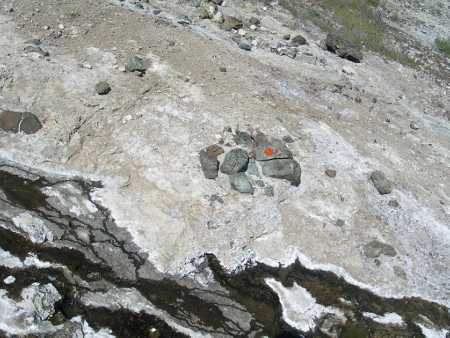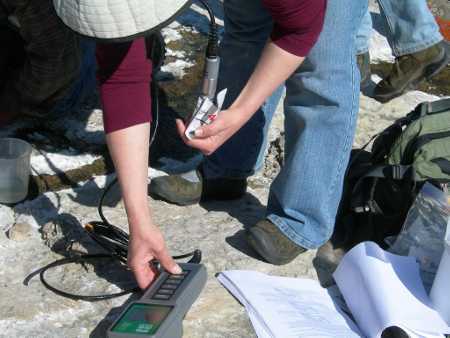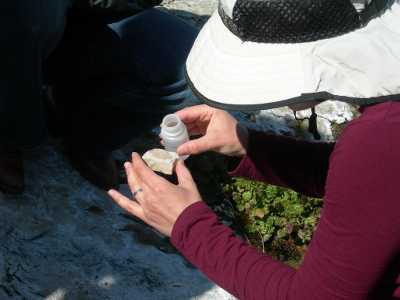
LAKE COUNTY, Calif. – Serpentine, California's state rock, can be found in abundance in Lake County.
Although beautiful to gaze upon, the soils it forms makes for poor gardening conditions.
It is recommended that when selecting plants for landscaping, you should select species native to these soils, such as those recommended by the California Native Plant Society.
Serpentine is actually a mineral, and comes in an array of colors. It can vary from yellow to black, but is often green in color here in Lake County.
A rock made up primarily of serpentine minerals is also known as serpentinite. It's not truly a single mineral, but instead, an assemblage of related minerals such as antigorite and chrysotile. Chrysotile's fibrous form is a type of asbestos.
Serpentine has a silky smooth, wax-like feel to it. Outcrops of our state rock can be found over 2,200 square miles in California, and other exotic places on earth related to tectonic plate convergence, such as the Philippines.
According to local geologist, Dean Enderlin, “The formation of serpentinite is a very complex process. Much has been (and is being) written about it in geology journals. Serpentine minerals form when unstable ultramafic minerals in the deeper parts of an ophiolite complex chemically react with sea water (they hydrate).”
To put this in layman's terms, millions of years ago Lake County was under the ocean – up to about the Sierra Nevada foothills. The land below this ocean underwent a great collision of earth's tectonic plates.
This particular under-ocean movement, called subduction, caused the floor which was west of us to move toward us, and under us. This complex process created our unique serpentine-rich geology.
Enderlin said, “Lake County geology can be divided into two assemblages of rocks: 1) The basement rocks, which go back to a time when our area was in the deep ocean; 2) The overlying rocks, which include volcanic deposits and lake beds, which are much younger than the basement.”

He continued, “ The process rarely fully converts the original minerals, so geologists often say that a rock is 'serpentinized' or 'partially serpentinized.' In our area the most commonly serpentinized rock is peridotite. Each mineral within the original peridotite will undergo a different chemistry (there are over 20 serpentine minerals). To complicate life, most serpentine minerals can only be identified using a petrographic microscope and other lab equipment.”
Lake County's serpentine outcrops are so special, that the University of California has been studying them at McLaughlin Natural Reserve, located at the confluence of Lake, Napa and Yolo Counties, where the old Homestake Mine once operated.
Along with university scientists, NASA scientists, like Dr. Jen Blank, PhD, Space Sciences & Astrobiology Division at NASA Ames Research Center, and Dr. Dawn Cardace, also affiliated with the NASA Ames Team through her postdoctoral fellowship (2007-2010), now on the faculty at the University of Rhode Island in the Department of Geosciences.
Blank, a scientist on the Mars Science Laboratory team which operates the Curiosity Rover on Mars, believes our Lake County area has some unique serpentine forms which are used as an analog to formations on Mars.
“Some of the heat from the Geysers near you comes from hydrothermal circulation through ultramafic rocks,” said Blank.
She said that serpentine is formed from the “reaction of warm water with ultramafic minerals such as olivine and pyroxene that are rich in iron and magnesium. The conversion of ultramafic minerals into serpentine has some interesting consequences. You're going from denser material to less-dense, less-ordered material- and this expansion produces cracks in the rocks, allowing more fluids to percolate through them and promoting additional chemical reactions.
“By-products of the serpentinization reaction include reduced gases such as methane and hydrogen- these can be used as energy/food by chemotrophic bacteria,” Blank said. “Methanogens and sulfur reducing bacteria able to thrive on these gases can support other microbes in a subsurface environment – which may be a place to look for life on Mars.”
She added, “On Mars, we think we see evidence of hydrothermal alteration as a result of impact craters- rather than tectonic activity.”

Dr. Dawn Cardace conducted research on Lake County's serpentine at McLaughlin Natural Reserve as part of a consortium of scientists who are looking at “life in hostile places.”
“They have drilled numerous wells on the Reserve which they use to 'observe' microbial life in the nasty high pH waters deep within the serpentinized areas,” said McLaughlin Natural Reserve's co-director, Cathy Koehler.
They call their project “CROMO,” which stands for Coast Range Ophiolite Microbial Observatory.”
“The reaction of water with minerals from Earth’s mantle transforms large swaths of the planetary subsurface over geologic time,” said Cardace. “As the minerals, olivine and serpentine react, they liberate hydrogen: this is an excellent source of energy for microbes living beyond the reach of our Sun. As yet uncharted deep habitat exists in Earth and many planetary bodies, and may host amazing life. This work underscores the scholarly importance of these sites in geobiology.”
NASA astrobiologist, Dr. Chris McKay suggests viewing the video below, which gives further information on serpentinization, and discusses studies at McLaughlin Reserve.
Kathleen Scavone, M.A., is an educator, potter, writer and author of “Anderson Marsh State Historic Park: A Walking History, Prehistory, Flora, and Fauna Tour of a California State Park” and “Native Americans of Lake County.” She also writes for NASA and JPL as one of their “Solar System Ambassadors.” She was selected “Lake County Teacher of the Year, 1998-99” by the Lake County Office of Education, and chosen as one of 10 state finalists the same year by the California Department of Education.

 How to resolve AdBlock issue?
How to resolve AdBlock issue? 



